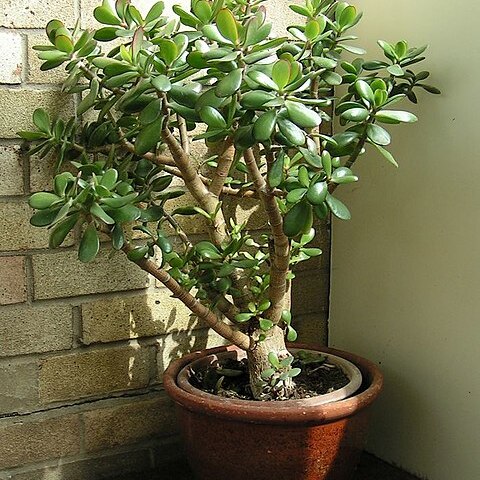Annual, biennial, or perennial herbs or shrubs [rarely scandent], succulent. Stems mostly alike and all potentially flowering, (flowering stems annual, axillary, overtopping primary stem). Leaves usually persistent, sometimes deciduous or caducous, cauline or sometimes in dense basal rosettes, alternate, opposite, or whorled, simple (pinnate in Bryophyllum), (heteromorphic in Dudleya, Echeveria, Graptopetalum); stipules absent; petiole usually absent; blade margins usually entire, sometimes toothed or lobed. Inflorescences terminal or axillary, spikes, thyrses, or mostly cymes, branches commonly cincinni (scorpioid cymes) and at first commonly coiled, or rarely flowers solitary. Flowers bisexual (sometimes unisexual in Rhodiola), radially symmetric (except sometimes calyx); perianth and androecium hypogynous or weakly perigynous; hypanthium present; sepals (3-)4-5(-12)[-30+], distinct or connate basally (or into tube); petals (3-)4-5(-12)[-30+], distinct or connate basally or sometimes into tube, margins entire (fimbrillate in Jovibarba, crenate in Phedimus); nectaries as scales at base of carpels; stamens as many as sepals or 2 times as many and in 2 series, antipetalous if in 1 series, free or adnate to corolla base (or tube); anthers dehiscent longitudinally and laterally; pistils (3-)4-5(-12)[-30+] [rarely fewer than sepals], mostly distinct or nearly so, (3-)4-5(-12)[-30+]-carpellate; ovary superior or semi-inferior, 1-locular; placentation submarginal; ovules anatropous, bitegmic, crassinucellate or tenuinucellate; styles (3-)4-5(-12)[-30+], terminal, distinct; stigmas (3-) 4-5(-12)[-30], terminal, capitate. Fruits usually whorls of follicles, each dehiscent along adaxial suture, rarely whorls of flimsy 1-seeded utricles (Sedella) or capsules of basally connate pistils (Diamorpha, Jovibarba). Seeds 1-20+ per carpel, brownish, fusiform or ellipsoid; embryo straight; endosperm oily, scant.
Annual, biennial or perennial herbs, rarely small shrubs, usually succulent. Leaves opposite or alternate, rarely verticillate, exstipulate. Flowers usually in terminal cymose inflorescences, less often in spikes or racemes or solitary in the leaf-axils, with or without bracts, regular, hermaphrodite, rarely unisexual and dioecious, mostly (3–)4–5(–±30)-merous. Sepals free or united into a tube, persistent. Petals the same number as the sepals, free or variously connate. Stamens hypogynous or epipetalous, as many as the petals or twice as many, and in 2 whorls, frequently obdiplostemonous; filaments free or adnate to the petals; anthers 2-thecous, introrse, opening by a longitudinal slit; scale-like nectaries usually present between the stamens and carpels. Carpels superior, equal in number to the petals, free or slightly connate at the base, 1-locular; ovules (few–)many, inserted on the adaxial suture; style short or elongated, stigmatose on the inner side of the apex. Fruit follicular, membranous or leathery, often surrounded by the persistent membranous corolla, opening on the adaxial side. Seeds minute; endosperm usually present; embryo straight
Herbs, subshrubs, or shrubs. Stems mostly fleshy. Leaves alternate, opposite, or verticillate, usually simple; stipules absent; leaf blade entire or slightly incised, rarely lobed or imparipinnate. Inflorescences terminal or axillary, cymose, corymbiform, spiculate, racemose, paniculate, or sometimes reduced to a solitary flower. Flowers usually bisexual, sometimes unisexual in Rhodiola (when plants dioecious or rarely gynodioecious), actinomorphic, (3 or)4-6(-30)-merous. Sepals almost free or basally connate, persistent. Petals free or connate. Stamens as many as petals in 1 series or 2 × as many in 2 series. Nectar scales at or near base of carpels. Follicles sometimes fewer than sepals, free or basally connate, erect or spreading, membranous or leathery, 1-to many seeded. Seeds small; endosperm scanty or not developed.
Ovary superior; carpels equal in number to the petals, free or united (up to the middle); ovules many or few to one in each carpel, anatropous, inserted on the adaxial suture; styles short, sometimes nearly absent or ± elongate; stigmas capitate
Flowers (3)4-5(6-32)-merous, actinomorphic, usually bisexual, in axillary or terminal cymes often grouped in corymb-or panicle-like inflorescences, less often in racemes or spikes or solitary in the leaf-axil
Stamens as many or twice as many as the petals, if few then alternate with the petals, slightly perigynous; filaments free; anthers 2-celled, introrse, dehiscing longitudinally
Stamens as many or twice as many as the petals; filaments free or more or less connate with the corolla-tube; anthers 2-celled, introrse, basifixed, dehiscing longitudinally
Carpels superior, the same number as the petals free or united at the base, 1-celled; ovules many or rarely few, inserted on the adaxial suture; styles short or elongated
Leaves opposite, verticillate or alternate, usually simple, sometimes compound, exstipulate, often ± thick and fleshy-succulent
Fruit follicular, membranous or leathery, often surrounded by the persistent membranous corolla, opening on the adaxial side
Hypogynous scales (scale-like nectaries) usually present, small, applied to the base of the outer face of the carpels
Seeds mostly minute with smooth, rugose or tuberculate tegument and usually fleshy endosperm; embryo straight
Fruit follicular, membranous or leathery, opening along the free part of the adaxial suture
Herbs and undershrubs, usually succulent; leaves opposite or alternate, exstipulate
Annual, biennial or perennial herbs, undershrubs or shrubs, usually ± succulent
Petals the same number as the sepals, free or variously connate, hypogynous
Seeds mostly minute, usually with fleshy endosperm; embryo straight
Sepals free or ±: united at the base, sometimes in a ± long tube
Petals as many as the sepals, free or ± connate, hypogynous
Flowers actinomorphic, hermaphrodite, usually cymose
Sepals free or united into a tube, often 4 or 5
Hypogynous scales present within the stamens

